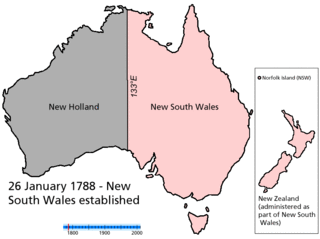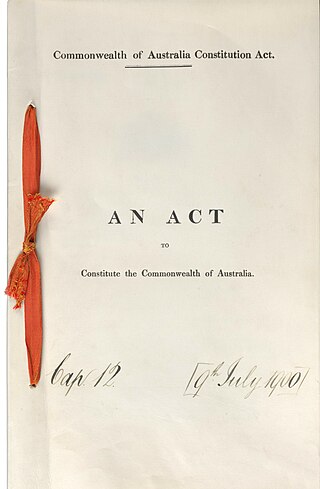
The Senate is the upper house of the bicameral Parliament of Australia, the lower house being the House of Representatives. The composition and powers of the Senate are established in Chapter I of the Constitution of Australia. There are a total of 76 senators: 12 are elected from each of the six Australian states regardless of population and 2 from each of the two autonomous internal Australian territories. Senators are popularly elected under the single transferable vote system of proportional representation.

The Parliament of Australia is the supreme legislative branch of the government of Australia. It consists of three elements: the monarch, the Senate and the House of Representatives. The combination of two elected chambers, in which the members of the Senate represent the states and territories while the members of the House represent electoral divisions according to population, is modelled on the United States Congress. Through both chambers, however, there is a fused executive, drawn from the Westminster system.
Ratification is a principal's legal confirmation of an act of its agent. In international law, ratification is the process by which a state declares its consent to be bound to a treaty. In the case of bilateral treaties, ratification is usually accomplished by exchanging the requisite instruments, and in the case of multilateral treaties, the usual procedure is for the depositary to collect the ratifications of all states, keeping all parties informed of the situation.
Australian constitutional law is the area of the law of Australia relating to the interpretation and application of the Constitution of Australia. Legal cases regarding Australian constitutional law are often handled by the High Court of Australia, the highest court in the Australian judicial system. Several major doctrines of Australian constitutional law have developed.

The second question of the 1967 Australian referendum of 27 May 1967, called by the Holt government, related to Indigenous Australians. Voters were asked whether to give the Federal Government the power to make special laws for Indigenous Australians in states, and whether Indigenous Australians should be included in official population counts for constitutional purposes. The term "the Aboriginal Race" was used in the question.
In Australia, referendums are public votes held on important issues where the electorate may approve or reject a certain proposal. The term is commonly used in reference to a constitutional referendum which is legally required to make a change to the Constitution of Australia.
The Constitution Alteration Bill 1928, was approved by referendum on 17 November 1928. The amendment to the Australian constitution concerned financial relations between the Commonwealth of Australia and the Australian states. It became law on 13 February 1929.

On 22 September 1951, a referendum was held in Australia which sought approval to alter the Australian Constitution to give Parliament the power to make laws regarding communism and communists, so that the Parliament would be empowered to instate a law similar to the Communist Party Dissolution Act of 1950. It was not carried.
The Constitution Alteration (Referendums) Bill 1977 was an Australian referendum held in 1977 in which electors approved an amendment to the Australian constitution to allow electors in the Australian territories to vote at referendums. Electors in the territories were to be counted towards the national total, but would not be counted toward any state total.
The referendum of 13 April 1910 approved an amendment to the Australian constitution. The referendum was for practical purposes a vote on the Constitution Alteration Bill 1909, which after being approved in the referendum received the Royal Assent on 6 August 1910.
The Constitution Alteration Bill 1974, was an unsuccessful proposal to alter the Australian Constitution to make it easier to amend the constitution and give voters in the Australian territories the right to vote in referendums. It was put to voters for approval in a referendum held on 18 May 1974.

There have been numerous proposals for the creation or incorporation of new states of Australia, since the late 19th century. Chapter VI of the Constitution of Australia provides for the admission of new states to the federation. Proposals have included admitting territories to statehood, admitting independent countries, and forming new states from parts of existing states. However, no new states have been added since the federation of six former British self-governing colonies in 1901, as states of the new Commonwealth of Australia.
The separation of powers in Australia is the division of the institutions of the Australian government into legislative, executive and judicial branches. This concept is where legislature makes the laws, the executive put the laws into operation, and the judiciary interprets the laws; all independently of each other. The term, and its occurrence in Australia, is due to the text and structure of the Australian Constitution, which derives its influences from democratic concepts embedded in the Westminster system, the doctrine of "responsible government" and the United States version of the separation of powers. However, due to the conventions of the Westminster system, a strict separation of powers is not always evident in the Australian political system, with little separation between the executive and the legislature, with the executive required to be drawn from, and maintain the confidence of, the legislature; a fusion.
Section 51(xxxvii) of the Constitution of Australia is a provision in the Australian Constitution which empowers the Australian Parliament to legislate on matters referred to it by any state. As Australia is a federation, both states and the Commonwealth have legislative power, and the Australian Constitution limits Commonwealth power. Section 51(xxxvii) allows for a degree of flexibility in the allocation of legislative powers.
In Australian constitutional law, Chapter III Courts are courts of law which are a part of the Australian federal judiciary and thus are able to discharge Commonwealth judicial power. They are so named because the prescribed features of these courts are contained in Chapter III of the Australian Constitution.
The State of North Queensland is a proposed state of Australia, to be formed out of the current state of Queensland. The proposal does not have the support of the two major political parties that dominate politics in Queensland.

The Constitution of Australia is the supreme law of Australia. It is a written constitution that sets down the political structure of Australia as a federation under a constitutional monarchy and outlines the structure and powers of the Australian Government's three constituent parts: the executive, legislature, and judiciary.
Section 122 of the Constitution of Australia deals with matters relating to the governance of Australian territories. It gives the Commonwealth Parliament complete legislative power over the territories. This power is called the territories power. The extent and terms of the representation of the territories in the House of Representatives and the Senate are also stated as being at the discretion of the Commonwealth Parliament.
Chapter V of the Constitution of Australia deals with the relationship between the states and the Commonwealth, and other matters pertaining to the states.
The Constitution Alteration Bill 1988, was an unsuccessful proposal to alter the Australian Constitution to enshrine the principle that each elector's vote should have equal value in Australia, also referred to as one vote, one value, including in states and territories. It was put to voters for approval in a referendum held on 3 September 1988.




